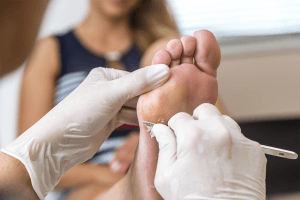Clinical Contamination Control
Automated (passive) scalpel blade removers (SBRs) are used by doctors, podiatrists, and healthcare workers all around the world. They provide a single-handed way of removing scalpel blades that is far safer than traditional methods like using forceps and reduce contamination.
The Qlicksmart BladeFLASK, for example, is one of the world’s first single-handed scalpel blade removers. It was designed to facilitate safe scalpel blade removal for healthcare workers so to avoid cuts and injuries.
The contamination issue.
With this in mind, it is important that practitioners ensure they use to right SBR for the right job. Failing to do so can result in contamination, transmission of disease, and possibly further consequences. Investigations have found that healthcare workers can actually contaminate their scalpel handles by using the wrong SBR. Examples of this contamination were found to be more common than originally thought.
An example.
Podiatrists use large amounts of scalpel blades during their procedures. The scraping of the blade on tough skins means scalpels become blunt more quickly. Consequently, podiatrists use their SBRs far more frequently than most other healthcare professions and sometimes in the middle of procedures. This removal of blades in the middle of procedures can possibly contaminate their scalpel handles.

How does contamination happen?
When a scalpel blade is removed by an SBR, the blade is typically concealed by the remover and discarded within, allowing the naked handle to be removed by the user. When performing this action however, the handle comes into contact with the SBR. The handle slides into the remover, behind the scalpel blade, contaminating the handle with fluids from the blade.
What can I do to stop contamination?
When this removal process is performed at the end of a procedure there are no issues. The handles would typically be taken away and not used again until they have been cleaned. When removal is performed in the middle of the procedure however, fluids from the handle can contaminate a new scalpel blade, the patient, other instruments, and even staff members. This raises the possibility of blood-borne disease transmission.
Governing Healthcare bodies have formulated a number of immediate courses of action clinics could take to help mitigate these contamination risks:
- Identify clinical procedural areas that use SBRs
- Risk assess the need to modify the use of SBRs based on type of clinical procedures that use scalpel blades.
- Do no reuse scalpel handles once they have been inserted into an SBR.
- Dispose of single use handles correctly.
- Do not manually remove blades.
- At the end of a procedure:
- Appropriately dispose of single use handles
- Reprocess reusable hands according to Australian Standard 4187:2014 “Reprocessing of reusable medical devices in health service organisations”.
These guidelines are a first huge step towards a safer work environment in healthcare clinics that use SBRs. When followed correctly, the risk of contaminating a scalpel handle and procedures is mitigated, creating the clinic safer for both patients and staff.

